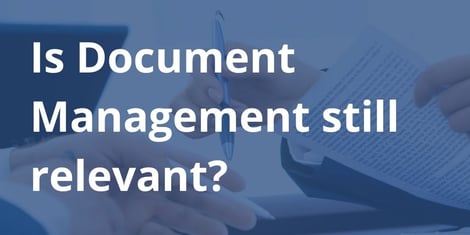
Is Document Management still relevant?
Document management is a mature technology and has been around since the 1980s. However, its significance remains high on the business agenda, especially for functional heads who deal with paper-heavy processes. Best examples of these processes are accounts payable, complaints handling, contract management, and HR onboarding. According to recent research in the UK, 57 per cent of all invoices are still received on paper and take more than seven days to process.
Also, some industries, particularly those highly regulated such as legal, financial, manufacturing, logistics, and healthcare, may have to comply with legal and regulatory rules mandating paper records. An example these circumstances could be when a so-called “wet signature” (versus a digital one) is required.
However, the way businesses receive information has changed. Companies now receive a mix of paper and e-invoices (received as email attachments by the accounts department or via EDI). Document Management technology has expanded to accommodate changes in the way information enters an organisation. EDM solutions treat electronic information in the same way as they treat paper, and create a centralised, structured library of electronic documents. This could include email attachments, document images, and electronic data received via an electronic exchange such as via payment portals. If not handled properly all this information could end up in digital chaos which will cause delays, errors, and in-efficiencies in dependent processes. For example, three out of five companies receive duplicate supplier invoices, increasing the margin for error.
“Three out of five companies received duplicate supplier invoices, increasing margin of error”
Traditional Document management vs Cloud Solution
The solution to some of the above challenges were offered by traditional document management system and most large enterprises would use some kind of document management software, typically installed on their servers. Small to medium sized businesses still suffer from scattered storage of documents and hence would more likely relate to above challenges.
The new, lighter cloud-based version of document management systems is more aligned to the new user needs. It carries over all the robust features of a traditional document management system and is accessible via mobile devices and provides integration with other business systems to enable information sharing between systems without the need for data entry.
There are new features that make compliance to new regulations easier by applying stricter corporate policies and ensuring a legally admissible audit trail is maintained.
There is something for the IT team too – it’s not disruptive, so you don’t have to derail your efforts from any other critical project to get started.
Convinced cloud-based Document Management is right for you?
And don’t know where to start. Here are there steps we recommend you should take towards getting a quick return on “document management” investment.
Three steps to pick the ideal document management system for you
1.Identify the right processes
A process that is document intensive and requires frequent exchange of information is right for application of document management. If the process requires geographically distributed teams to access information and process it, then there is a strong case for cloud-based solution. This enables distributed teams to access one version of documents from anywhere at any time.
Some such processes include contract management, employee on-boarding and offboarding, employee records management and invoice processing. Identifying correct processes can yield substantial results in a very short period, demonstrating quick return on investment.
2.Ensure information flows seamlessly between systems
If we take the example of processes mentioned above, its easy to see that we could benefit most from a document management system if it allowed documents to be seen across systems where teams would look at documents. For example, for processing invoices: accounts payable team would like to see the invoices in an accounting system, for a contract management process: Procurement team would like to see proof of delivery, driver contracts in an ERP system.
Ensure the document management system that you choose allows this exchange of information easily. This would result in complete accessibility of documents and no hold ups or delays in processes.
3.Train users and manage change
If the user interface is complicated and it makes the users life even more difficult, then they will quickly revert to old ways of storing data on local/shared drives and data entry. If the user interface is simple and users are well trained as per their role in managing documents, the adoption of the document management system will be quick. This will again result in quick return on investment.
So in summary due to the fact that document management technology has moved on considerably and now offers so much more and with cloud becoming the standard approach, it’s become more relevant than ever.
Twofold will be happy to help choose the right document management solution for you based on your needs or even optimise an existing solution. Talk to one of our business consultants today about your Document Management needs.
What next?
Twofold Ltd helps overcome these challenges by providing cloud or on-premise solutions for document management. Our range of services range from DocuWare for records management, to secure scanning and capture hardware and software. Contact us via the form here, or give the team a call on 0118 951 9800.
Karen James
Document management product specialist

.png?width=828&height=208&name=Twofold-Logos-no%20drop%20(1).png)
